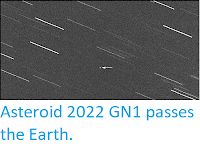Asteroid 2022 HM passed by the Earth at velocity of 14.61 km per second and a distance of about 245 300 km (0.64 times the average distance between the Earth and the Moon, or 0.16% of the distance between the Earth and the Sun), slightly after 1.40 am GMT on Thursday 21 April 2022. There was no danger of the asteroid hitting us, though were it to do so it would not have presented a significant threat. 2022 HM has an estimated equivalent diameter of 6-19 m (i.e. it is estimated that a spherical object with the same volume would be 6-19 m in diameter), and an object of this size would be expected to explode in an airburst (an explosion caused by superheating from friction with the Earth's atmosphere, which is greater than that caused by simply falling, due to the orbital momentum of the asteroid) between 38 and 24 km above the ground, with only fragmentary material reaching the Earth's surface.
2022 HM was discovered on 22 April 2022 (the day after its closest approach to the Earth) by the Piszkés-Tető Mountain Station of the Hungarian Academy of Science's Konkoly Observatory. The designation 2022 HM implies that the asteroid was the 12th object (asteroid M - in numbering asteroids the letters A-Z, excluding I, are assigned numbers from 1 to 25, with a number added to the end each time the alphabet is ended, so that A = 1, A1 = 26, A2 = 51, etc., which means that M = 12) discovered in the second half of April 2022 (period 2022 H - the year being split into 24 half-months represented by the letters A-Y, with I being excluded).
2022 HM is calculated to have a 448 day (1.23 year) orbital period, with an elliptical orbit tilted at an angle of 16.7° to the plain of the Solar System which takes in to 0.68 AU from the Sun (68% of the distance at which the Earth orbits the Sun, and slightly inside the orbit of the planet Venus) and out to 1.60 AU (1.60 times the distance at which the Earth orbits the Sun, and lightly more than the distance at which the planet Mars orbits). It is therefore classed as an Apollo Group Asteroid (an asteroid that is on average further from the Sun than the Earth, but which does get closer). This means that 2022 HM has occasional close encounters with the Earth, with the last thought to have happened in October 2020 and the next predicted in January 2027.
See also...



Follow Sciency Thoughts on Facebook.
Follow Sciency Thoughts on Twitter.





